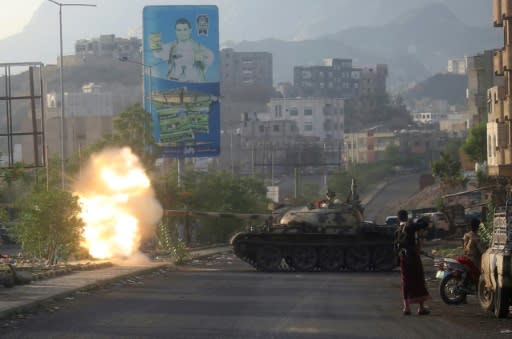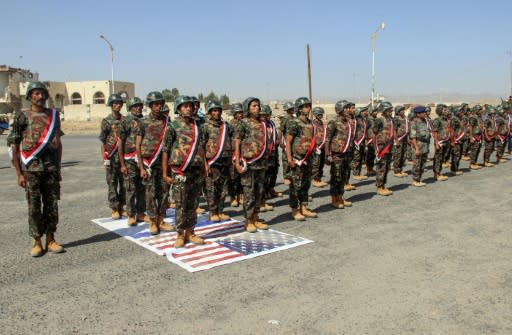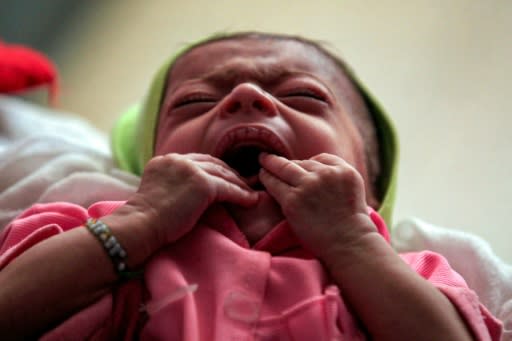Five years into war, Yemen at 'rock bottom'
Like most residents of Amran, a strategic gateway to Yemen's capital Sanaa, Mohammed al-Najri thought the capture of his city by Huthi rebels five years ago would not last long. But fighting quickly spread to most areas of the country, plunging the Arab world's most impoverished nation into a devastating conflict that is yet to end. Fifty kilometres (30 miles) north of Sanaa, Amran was taken by the Iran-backed Huthis on July 8, 2014. It was the first major city to fall, in a military campaign that saw the rebels seize vast swathes of Yemen from the internationally recognised government. At the education ministry office in Amran where he works, Najri has gone without his salary ever since the beleaguered government two years ago moved the central bank from Sanaa to Aden, its makeshift capital. "Five years have passed since the war broke out, but we know there is still a long way to go," the 40-year-old civil servant told AFP by telephone. "Our situation has deteriorated ... We have reached rock bottom. Everything has collapsed," he said. Mohammed Taha, 48, a journalist from Amran who has continued to cover his home city since the Huthis seized it, does not even consider the possibility of peace. "Five years of war were sufficient for me to adapt and adjust my life and that of my family accordingly," Taha told AFP. "Yes, we were affected by the war at the start, but we were able to live with its consequences. I no longer care if it continues or ends," he said. - 'Dangerous' plot - The United Nations says Yemen is experiencing the world's worst humanitarian crisis, warning that millions are on the verge of famine. Thousands of civilians, including hundreds of children, have been killed and tens of thousands wounded. Essential health, education and other services have all but collapsed, especially since a Saudi-led coalition intervened in March 2015 in support of the government. In Amran, rebels carrying automatic rifles remain vigilant day and night, while revolutionary slogans are daubed everywhere on the old city's brown buildings made of clay and stones. "Death to America, Death to Israel, Curse on Jews and victory for Islam," reads one slogan. Two Yemeni government officials told AFP that when Amran fell into the hands of the Huthis, no one was aware of the rebels' plans to take their military campaign to Sanaa and other regions. Beyond the city limits, Amran is a key province in Yemen historically, boasting important archeological landmarks, including the 100-year-old Shaharah Bridge -- meaning the 'bridge of sighs' -- which links two mountains. It is also home to Raydah town, where the last of Yemen's Jews lived, before they made their way to Israel in 1949-1950 in a secret airlift dubbed "Operation Magic Carpet". Amran occupies a strategic location between Sanaa and the rebels' stronghold of Saada in the far north. It is also home to the Hashid, Yemen's most powerful tribe. - 'Almost unimaginable' - The Huthis overran government forces in Amran after a two-month siege and then moved south, capturing the capital in September 2014 before pushing into other parts of Yemen. Sixty months after seizing the city, the rebels still hold the upper hand on the battlefield, despite major military campaigns by the government and airstrikes by the Saudi-led coalition. The rebels still hold a firm grip on Sanaa and most cities in northern, central and western regions including the strategic Red Sea port city of Hodeida. They have made strong use of their fighting experience in mountain ranges. But the war has devastated Yemen. It "has fragmented the country down the lines of identity, geography and ideology in ways that were almost unimaginable before it began," Peter Salisbury, a Yemen analyst at the International Crisis Group, told AFP. The rebels and the government have participated in several rounds of UN-sponsored talks, the last held in Sweden in December, but they failed to strike a deal to end the bloody war. The United Nations says that 3.3 million Yemenis are displaced, while at least 24 million -- some two-thirds of the population -- need assistance. "The country is not on the verge of collapse, it is collapsing. It is collapsed actually," Fabrizio Carboni, the International Committee of the Red Cross regional director for the Near and Middle East, said in Geneva on Thursday. For Salisbury, "it will take a lot more than five years to get us back to even 2014 levels of internal cohesion, if at all, (in terms of) service delivery and economic development." Yemeni fighters loyal to exiled President Abedrabbo Mansour Hadi fire from a tank during clashes with Shiite Huthi rebels in the country's third-city of Taez Troops of Yemen's Shiite Huthi rebels at a graduation ceremony in the northwestern city of Saada An infant suffering from malnutrition cries at a treatment centre in hospital in Yemen's Huthi rebel-held capital Sanaa




